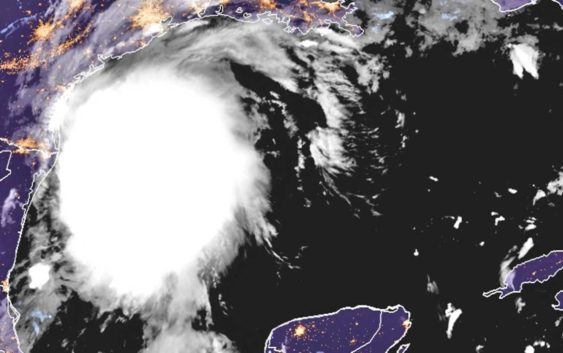- Caught on camera | Tornado touches down in Missouri
- Carolina Hurricanes playoff tickets go on sale next week
- Weather Impact Alert: Cold front could trigger severe weather in Houston area this weekend | See timeline
- Violent storms cut through the South and Midwest, spawning tornadoes and killing 3
- Above-normal active 2025 hurricane season predicted by Colorado State University
Tropical Storm Nicholas threatens Gulf Coast with heavy rain

Forecasters at the National Hurricane Center in Miami said Nicholas was strengthening, churning up top winds of 60 mph (95 kph). It was traveling north-northwest at 14 mph (22 kph) on a forecast track to pass near the South Texas coast later Monday, then move onshore along the coast of south or central Texas by Monday evening.
Nicholas was centered roughly 45 miles (75 kilometers) southeast of the mouth of the Rio Grande River, and 200 miles (325 kilometers) south of Port O’Connor, Texas, as of Monday morning.
A hurricane watch was issued from Port Aransas to Freeport, Texas. Much of the state’s coastline was under a tropical storm warning as the system was expected to bring heavy rain that could cause flash floods and urban flooding.
Rainfall totals of up to 10 inches (25 centimeters) in Texas and southwest Louisiana were expected, with isolated maximum amounts of 20 inches (50 centimeters) across portions of coastal Texas from Sunday night through midweek.
Texas Gov. Greg Abbott said the state has placed rescue teams and resources in the Houston area and along the Texas Gulf Coast.
“This is a storm that could leave heavy rain, as well as wind and probably flooding, in various different regions along the Gulf Coast. We urge you to listen to local weather alerts, heed local warnings,” Abbot said in a video message.
Louisiana Gov. John Bel Edwards on Sunday night declared a state of emergency ahead of the storm’s arrival in a state still recovering from Hurricane Ida and last year’s Hurricane Laura and historic flooding.
“The most severe threat to Louisiana is in the southwest portion of the state, where recovery from Hurricane Laura and the May flooding is ongoing. In this area heavy rain and flash flooding are possible. However, it is also likely that all of south Louisiana will see heavy rain this week, including areas recently affected by Hurricane Ida,” Edwards said.
The storm was expected to bring the heaviest rainfall west of where Hurricane Ida slammed into Louisiana two weeks ago. Although forecasters did not expect Louisiana to suffer from strong winds again, meteorologist Bob Henson at Yale Climate Connections predicted rainfall could still plague places where the hurricane toppled homes, paralyzed electrical and water infrastructure and left at least 26 people dead.
“There could be several inches of rain across southeast Louisiana, where Ida struck,” Henson said in an email.
Across Louisiana, just over 110,000 customers remained without power early Monday, according to the utility tracking site poweroutage.us.
The storm is projected to move slowly up the coastland which could dump torrential amounts of rain over several days, said meteorologist Donald Jones of the National Weather Service in Lake Charles, Louisiana.
“Heavy rain, flash flooding appears to be the biggest threat across our region,” he said.
While Lake Charles received minimal impact from Ida, the city saw multiple wallops from Hurricane Laura and Hurricane Delta in 2020, a winter storm in February as well as historic flooding this spring.
“We are still a very battered city,” Lake Charles Mayor Nic Hunter said.
He said the city is taking the threat of the storm seriously, as it does all tropical systems.
“Hope and prayer is not a good game plan,” Hunter said.
In Cameron Parish in coastal Louisiana, Scott Trahan is still finishing repairs on his home damaged from last year’s Hurricane Laura that put about 2 feet of water in his house. He hopes to be finished by Christmas. He said many in his area have moved instead of rebuilding.
“If you get your butt whipped about four times, you are not going to get back up again. You are going to go somewhere else,” Trahan said.
Colorado State University hurricane researcher Phil Klotzbach said via Twitter that Nicholas is the 14th named storm of 2021 Atlantic hurricane season. Only 4 other years since 1966 have had 14 or more named storms by Sept. 12: 2005, 2011, 2012 and 2020.
Copyright © 2021 by The Associated Press. All Rights Reserved.